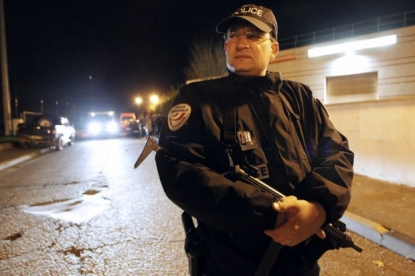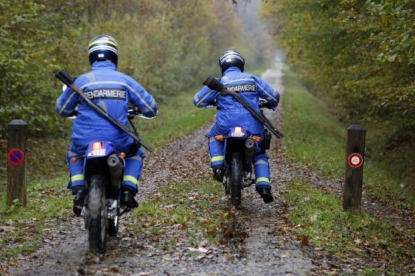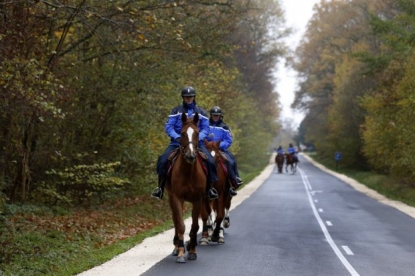On a tiger safari
BOBIGNY, France, December 19, 2014 – It’s a quiet Thursday morning in the AFP office in Bobigny, north Paris suburbs. My colleague Valentin leaves a voicemail for a police officer, checking a detail on a story, and hangs up ready to go to lunch – when the phone rings.
It’s the officer, clearly in a fluster, who appears to have dialed our number by mistake.
"Hello, Jerome? Call back the fire brigade. We can’t find IT.”
"IT", as we are about to find out, is the TIGER. The bloodthirsty beast that will keep us in hot pursuit for the next two days – under the amused eye of much of the world’s media.
Valentin manages to prise from his source the fact that a tiger – yes, a real tiger – has been sighted in the Seine-et-Marne district, northeast of Paris. Our colleague Francois Becker gets confirmation from a second police source, who tells him the animal was spotted near a supermarket in the suburb of Montevrain.
 A policeman stands guard as police and firefighters hunt for what was feared to be a tiger on the loose in Montevrain, near Paris on November 13, 2014 (AFP Photo / Matthieu Alexandre)
A policeman stands guard as police and firefighters hunt for what was feared to be a tiger on the loose in Montevrain, near Paris on November 13, 2014 (AFP Photo / Matthieu Alexandre)With two sources, we can go with the story. But how strong should we go with it? Hard to tell… What if the tiger turns out to be a tabby? We risk whipping up a storm over nothing. On the other hand, if it devours a passerby, we’ll be blamed for downplaying the event.
However fearsome the beast turns out to be, a major police operation is already underway to track it down - something not seen every day in the Paris suburbs. We decide that alone justifies sending a news alert.
At 12:13 pm we break the news: “Police, firefighters hunt for tiger on the loose near Paris”.
Another journalist in the office, Jessica Lopez, gets hold of the supermarket manager where it was spotted. He says his wife called him early that morning, saying she thought she had seen a lynx. She snapped a picture -- which he sends on to us -- a blurry shot of a red-furred creature, standing at the crest of a hill.
 The tiger (AFP Photo / Julie Berdeaux)
The tiger (AFP Photo / Julie Berdeaux)By now Valentin is on his way to Montevrain – a 45 minute journey on a good day – with video and photo teams coming from Paris to join us on our big cat hunt.
Suddenly, a news website announces the tiger has been found – our story is over. But we call our sources, who assure us it is still on the run. And so are we…
1:15 pm. We reach the site where the tiger is thought to be hiding out – an area of woodland the size of four or five football pitches.
Overhead a helicopter is circling, flying deliberately low to try to drive the beast from its lair. Dozens of firefighters, police and gendarmes, backed by wildlife experts, are gathered at the end of a road blocked off to traffic.
The mood is pretty relaxed– more amused than alarmed at the prospect of a tiger prowling these parts. A nice detail: the search operation has set up its HQ next to a tyre seller, Randos Pneus, whose logo is a big cat paw print.
Behind the security cordon, journalists bide their time. The mayor of Montevrain issues a statement urging residents to stay indoors – or inside their cars, and children to be kept inside school gates.
The man who saw the woman who saw the tiger
By now we are starting to get a profile of the mystery beast. Based on analysis of paw prints found in the area, we are told to expect an animal weighing “close to 70 kilos”.
On the car park, a squad of firefighters keeps watch, rifles in hand.
With no stripes in sight, journalists make do with the next-best thing -- the man who saw the woman who saw the tiger, in other words the supermarket manager, hero of the day.
Back in our Bobigny office, we are trying to find out where it could have come from. One by one we rule out the possibilities: the travelling circus that set up outside the supermarket a few days back, the big cat park 30 kilometres away. None are missing a tiger.
At Disneyland Paris, which is just around the corner from Montevrain, the only tiger on record is Winnie the Pooh’s irrepressible friend…
 'Tigger' greets then-interior minister Nicolas Sarkozy at Disneyland Paris on December 13, 2003 (AFP Photo / Francois Guillot)
'Tigger' greets then-interior minister Nicolas Sarkozy at Disneyland Paris on December 13, 2003 (AFP Photo / Francois Guillot)At the search site, we watch, and wait.
Finally, three men in military garb arrive in a four-wheel drive vehicle. Aha! Could the hunt be over? Not this time. Half an hour later they speed off again.
5:30 pm. Nothing new under the setting sun. A regional government official, Frederic Mac Kain, briefs television crews. The search has turned up nothing so far – so we are widening the operation. A glimmer of doubt starts to spread among the media pack, but the authorities are final.
“No doubt about it – it’s a tiger,” says Robert Picaud, the regional head of the French pest control agency, which mostly deals with foxes, badgers and boars.
"The paw prints are real. These prints and photos, leave no room for doubt," Picaud told us. The prints are fresh, he said, which means the animal was here just recently.
If the search is taking so long, a source close to the operation explains patiently, it’s because tigers like to take naps. They can fall asleep on a tree branch and stay unnoticed for hours on end.
At this point, we add a line into our story – pretty high up – cautioning that several big feline alerts in the past turned up nothing more than an overweight pussy cat.
 French lieutenant Robert Picaud speaks to the press about the 'tiger' on the loose (AFP Photo / Matthieu Alexandre)
French lieutenant Robert Picaud speaks to the press about the 'tiger' on the loose (AFP Photo / Matthieu Alexandre)The tiger crosses the highway
Night falls on the woods of Montevrain. The prefecture says it is cutting back the search operation for the night. A single helicopter, equipped with a thermal camera, will continue to circle above the area until dawn.
My colleague Valentin decamps for the evening, after hours shuffling about in the cold. I am on call for the rest of the night.
At 5:30 am, my alarm rings. I slept with one eye open for fear of missing the call from the prefecture announcing the animal’s capture. But no, the beast is still out there, somewhere.
I drive through the empty streets of Paris at 6 am, taking the A4 highway towards Montevrain. Unbeknownst to me, a driver has just reported sighting the animal by the side of the expressway I am travelling on. Forty-five minutes later I pull up outside the now-famous local supermarket.
The police are already there. Their mission for the day is to secure access to the town’s schools. Military reinforcements are on hand, too, awaiting orders. I get chatting with some fellow reporters – as bleary-eyed and freezing cold as I am – and we agree this wild goose chase has gone on long enough.
 French gendarmes join the search for the 'tiger' (AFP Photo / Thomas Samson)
French gendarmes join the search for the 'tiger' (AFP Photo / Thomas Samson)To feed the morning’s tiger hunt story I head to the local high school, where most of the students had been dropped off by car that morning. People are far from panicked – but they are certainly taking the safety warnings seriously.
A dad walks his gangly 15-year-old son right up to the school gate – and lets him go with a stern warning to “Be careful”. He explains to me: “It hasn’t eaten for two days!” He leans over the gate for a final word of warning to his son, by now chatting with his schoolmates: “You walk home with the neighbour, OK -- and don’t leave the house until I get back!”
Another group of kids are fooling around – one of them pretending to have seen the beast, while another explains how he plans to teach him a lesson if he shows his whiskers in these parts. A third kid is beaming with pride after being interviewed on TV.
So what should you do if you find yourself face to face with the tiger? They all know the drill: “Stand still and shout!”
Scream… preferably in German
My colleague Francois gets hold of a tiger expert from the Pinder circus, Gilbert Edelstein, who tells him the best response is to "scream as loud as possible. Even better, scream in German.
“The guttural sounds could scare him away," Edelstein explains, with a straight face.
I am just setting up in a café in Montevrain to write my story when I hear from the road traffic services that the tiger has been spotted near a service station on the A4. The prefecture calls a press conference for 11 am. Valentin offers to go. The tiger found at last?
No such luck. He gets there to be told the briefing has been called off. In fact – as we later find out – the authorities are getting serious doubts about their mystery feline, and are trying to scale things downs gently… to avoid red faces all round.
For it’s been more than 24 hours since the big cat sighting, and no one has reported a missing tiger. Francois spoke to a customs official who said the chance of a private individual illegally owning a tiger was next to nil. Lizards, snakes, poisonous frogs, perhaps. But not a tiger.
 French mounted gendarmes search for the 'tiger' in the woods of Ferrieres-en-Brie (AFP Photo / Thomas Samson)
French mounted gendarmes search for the 'tiger' in the woods of Ferrieres-en-Brie (AFP Photo / Thomas Samson)Back in the car, I head to the highway service area where the beast was -- allegedly -- last seen. A cluster of fellow journalists have been there for a while.
It’s pouring with rain.
The Pinder circus manager tells us the tiger “must be stressed out, on the edge. And at the same time he only wants one thing, which is for this to be over.”
Pretty much sums up the mood of the AFP tiger team.
At 1 pm, the Seine-et-Marne police chief pulls up outside the service area cafeteria. Clearly ill at ease she sidesteps our questions for a bit – before coming out with it.
Fresh analysis of the beast’s paws show that it’s not a tiger after all. A lynx then? the reporters ask, hopefully. Er, no. « Another species of feline,” is all she will say.
So a cat, you mean?
“Somewhere between a domestic cat and... a larger feline,” rules Eric Hansen of the French forestry and wildlife services. He tells us the only wild feline native to the area is the “forest cat” – a harmless creature in most respects identical … to a large housecat.
And that was the end of our tiger safari.
Eve Szeftel is an AFP reporter in Bobigny, north Paris suburbs. Her colleagues François Becker, Valentin Bontemps and Jessica Lopez contributed to this story.
 He would have loved to see Paris, but he lives in the New Delhi zoo (AFP Photo / Manan Vatsyayana)
He would have loved to see Paris, but he lives in the New Delhi zoo (AFP Photo / Manan Vatsyayana)

